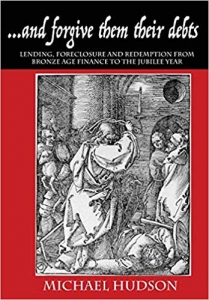In …and forgive them their debts: Lending, Foreclosure and Redemption From Bronze Age Finance to the Jubilee Year, Michael Hudson offers a historical account of the role that debt played in ancient societies. In focusing on how such societies dealt with the proliferation of debts that cannot be paid, this book sheds informative light on the significance of debt today, writes Alfredo Hernandez Sanchez, and is unlikely to leave the reader’s outlook on history, religion or economics unchallenged – or even unchanged – upon turning the last page.
…and forgive them their debts: Lending, Foreclosure and Redemption From Bronze Age Finance to the Jubilee Year. Michael Hudson. ISLET. 2018.
The Rosetta stone is famous for providing insight into the Ancient Egyptian language. It contains three versions of a decree issued by King Ptolemy V (196 BC), one of which was written in Ancient Greek. With this translation, modern Egyptologists were able to decode hieroglyphic scripts for the first time. This decree became so famous that the term ‘Rosetta stone’ has come to mean a clue into the unknown and a universal symbol for translation. Nonetheless, the content of the decree occupies little space in the collective imagination. This might seem perplexing, as if the ancient successor of Alexander the Great had instructed his scribes to produce something meant to last through the ages with nothing particularly interesting or important to say. However, as Michael Hudson points out in his most recent book, …and forgive them their debts, there is yet another insight into the ancient world the Rosetta stone has to offer: it is a debt annulment proclamation. In fact, ‘the vast majority of cuneiform tables are debt contracts and administrative accounts’ (55).
Hudson is best known for being one of the few economists who accurately predicted the 2008 financial crisis. The son of one of the leaders of the 1930s Minneapolis general strikes, and himself Leon Trotsky’s godson, the author has one of the most unusual backgrounds for an economist one could imagine. He graduated in 1959 from the University of Chicago, in Germanic philology. Throughout his long career he has been a musical conductor, a Wall Street financial analyst and an economic advisor for the CIA and several governments. He is currently a distinguished professor at the University of Missouri, Kansas City. Hudson is also a prolific author on matters of finance and economics, with …and forgive them their debts being on the best books list of the Financial Times for 2018.
The core assumption underlying his economic analysis is simple: as a law of mathematics, debts growing at compound interest are irremediably bound to overtake – typically s-curve – economic growth. In this book, Hudson recounts how scribes from ancient Babylonian temples (2,000 BC) were trained to be aware of this phenomenon: debts tend to become unpayable. This is the logic behind the adage with which the author is most closely associated: ‘Debts that can’t be paid, won’t be.’ The real question is how they won’t be paid, by way of write-downs or foreclosures.
The idea that debts could – let alone should – be successfully forgiven is a controversial one. The 2012 Greek financial crisis is an example of how sensitive the issue is even today. Who is to be held responsible when things go awry? If debts are to be forgiven, why would anyone lend in the first place? Hudson claims that, contrary to widespread economic beliefs, most debts have not arisen as a result of loans for productive enterprise. Throughout antiquity they were mostly back fees from failed crops or other unpaid tax obligations. Thus, when sovereign rulers proclaimed clean slates of personal debts – contracts for financing trade were typically exempted – they were cancelling obligations owed mostly to themselves.
 Image Credit: Stained glass window image of Jesus turning the Money Lenders from the Window, St Mary’s, Nottingham (Jules & Jenny CC BY 2.0)
Image Credit: Stained glass window image of Jesus turning the Money Lenders from the Window, St Mary’s, Nottingham (Jules & Jenny CC BY 2.0)
Such periodic debt amnesties by rulers had a dual purpose: a) preserving the economic solvency of the population, and with it its ability to supply corvée labour and taxable surpluses; and b) preventing the rise of a creditor oligarchy capable of rivalling – or limiting – royal power. Evidence of such practices can be found from ancient Sumer (2,500 BC) to Byzantium. According to Hudson’s reading of history, the State ‘is an arena in which creditors, landowners and rulers vie for control’ (262). Rulers were, however, not acting to safeguard the freedom of the peasantry for its own sake. They were upholding their own right to levy armies of small landowners and tax them. Nevertheless, ‘privatization of credit ultimately became a force sweeping aside the checks and balances that existed at the Mesopotamian outset’ (62). From the transition toward feudalism in the West to the decline of Constantinople in the East, this tension has shaped the course of history, politics and even religion.
Hudson points to the book of Leviticus – third of the Torah and the Old Testament – and claims that it is a warning to the people of Israel of the dangers that unpayable debts pose for a society, if not for the individual soul of the usurer. ‘Judah’s conquest by foreign powers is construed as divine warning not to forgo the laws of Leviticus’ (215). The New Testament has similar cautions, from the parable of the unmerciful servant to the retributive imagery of the Last Judgment. The author claims that early Christianity was about expanding the tradition of the Jubilee: ‘a radical agenda to redeem the poor from debt bondage’ (224). It is thus representative of the triumph of the idea that debts are sacred that ‘Jesus was transformed from the Lord’s messenger bringing good news of a clean slate, to become the Christ preaching forgiveness on a more abstract spiritualized plane’ (224). After all, it was his attempt to bring back debt cancellations to Judea – epitomised by his ejection of the money lenders from the temple, an image of which is also the cover of the book – that sparked outrage amongst the Pharisees, leading to his crucifixion.
Hudson is not the first in recent years to point to the strong links between debt and morality. Scholars like David Graeber and Kenneth Dyson finds similar patterns. However, in …and forgive them their debts, Hudson goes further. This is a book that aims, and categorically succeeds, to be controversial. Most (so-called) neoliberal economists will struggle with the idea that the enforcement of creditor’s rights is a historical tool for exploitation by oligarchs. After all, the debtor is typically understood to have an advantage as she has more information on her ability (and willingness) to fulfil her obligations. Many Christians are bound to experience some discomfort upon reading Hudson’s conclusions that the Bible is more about debts than sins. Even strict Marxists and some contemporary progressives may be challenged by the notion that religion has not in fact been the opium of the people, but an avenue for their redemption and a bulwark for their freedom throughout history. Nonetheless, the author’s work is scholarly enough to force most such stances into genuine reflection.
Nearly anyone with the necessary patience will benefit from reading this book. Alas, Hudson does not make the task an easy one. The book demands an encyclopedic knowledge of the history of the Bronze Age – though more realistically an actual encyclopedia – on the part of the reader, lest one gets lost in a maze of facts and terms that are as informative as they are obfuscating. Nevertheless, the effort is well worth it. Just as it is difficult to imagine someone being indifferent to Hudson’s arguments and findings, it is equally difficult to conceive anyone whose outlook on history, religion and/or economics will be left unchallenged – or even unchanged – upon turning over the last page.
- This review originally appeared at the LSE Review of Books.
Please read our comments policy before commenting.
Note: This article gives the views of the authors, and not the position of USAPP– American Politics and Policy, nor of the London School of Economics.
Shortened URL for this post: http://bit.ly/2MavBje
About the reviewer
Alfredo Hernandez Sanchez – Central European University
Alfredo Hernandez Sanchez is a doctoral researcher in Political Economy at the Central European University. His main research interests are international finance and geopolitics. He has been a lecturer at the American University of Central Asia and the OSCE Academy in Bishkek. Find out more about his work here.


 Find this book:
Find this book: 



